Gilgamesh › Hannibal › Minoan Civilization » Origins and History
Articles and Definitions › Contents
- Gilgamesh › Who Was
- Hannibal › Who Was
- Minoan Civilization › Antique Origins
Ancient civilizations › Historical places, and their characters
Gilgamesh › Who Was
Definition and Origins
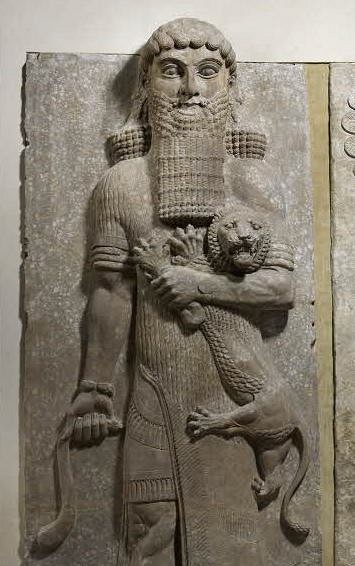
Gilgamesh is the semi-mythic King of Uruk in Mesopotamia best known from The Epic of Gilgamesh (written c. 2150 - 1400 BCE) the great Sumerian/Babylonian poetic work which pre-dates Homer ’s writing by 1500 years and, therefore, stands as the oldest piece of epic world literature.
The motif of the quest for the meaning of life is first fully explored in Gilgamesh as the hero-king leaves his kingdom following the death of his best friend, Enkidu, to find the mystical figure Utnapishtim and gain eternal life. Gilgamesh's fear of death is actually a fear of meaninglessness and, although he fails to win immortality, the quest itself gives his life meaning. This theme has been explored by writers and philosophers from antiquity up to the present day.
HISTORICAL & LEGENDARY KING
Gilgamesh's father is said to have been the Priest-King Lugalbanda (who is featured in two Sumerian poems concerning his magical abilities which pre-date Gilgamesh ) and his mother the goddess Ninsun (also known as Ninsumun, the Holy Mother and Great Queen). Accordingly, Gilgamesh was a demi-god who was said to have lived an exceptionally long life (the Sumerian King List records his reign as 126 years) and to be possessed of super-human strength.
Known as 'Bilgames' in the Sumerian, 'Gilgamos' in Greek, and associated closely with the figure of Dumuzi from the Sumerian poem The Descent of Inanna, Gilgamesh is widely accepted as the historical 5th king of Uruk who reigned in the 26th century BCE. His influence was so profound that myths of his divine status grew up around his deeds and finally culminated in the tales found in The Epic of Gilgamesh. Later Mesopotamian kings would invoke his name and associate his lineage with their own. Most famously, Shulgi of Ur (2029-1982 BCE), considered the greatest king of the Ur III Period (2047-1750 BCE) in Mesopotamia, claimed Lugalbanda and Ninsun as his parents and Gilgamesh as his brother to elevate his reign in the eyes of the people.
Known as 'Bilgames' in the Sumerian, 'Gilgamos' in Greek, and associated closely with the figure of Dumuzi from the Sumerian poem The Descent of Inanna, Gilgamesh is widely accepted as the historical 5th king of Uruk who reigned in the 26th century BCE. His influence was so profound that myths of his divine status grew up around his deeds and finally culminated in the tales found in The Epic of Gilgamesh. Later Mesopotamian kings would invoke his name and associate his lineage with their own. Most famously, Shulgi of Ur (2029-1982 BCE), considered the greatest king of the Ur III Period (2047-1750 BCE) in Mesopotamia, claimed Lugalbanda and Ninsun as his parents and Gilgamesh as his brother to elevate his reign in the eyes of the people.

Map of Sumer
DEVELOPMENT OF THE TEXT
The Akkadian version of the text was discovered at Nineveh, in the ruins of the library of Ashurbanipal, in 1849 CE by the archaeologist Austin Henry Layard. Layard's expedition was part of a mid-19th century CE initiative of European institutions and governments to fund expeditions to Mesopotamia to find physical evidence to corroborate events described in the Bible.What these explorers found instead, however, was that the Bible - previously thought to be the oldest book in the world and comprised of original stories - actually drew upon much older Sumerian myths.
The Epic of Gilgamesh did likewise as it is a compilation of tales, no doubt originally passed down orally, which was finally written down 700-1000 years after the historical king's reign. The author of the version Layard found was the Babylonian writer Shin-Leqi-Unninni (wrote 1300-1000 BCE) who was thought to be the world's first author known by name until the discovery of the works of Enheduanna (2285-2250 BCE), daughter of Sargon of Akkad. Shin-Leqi-Unninni drew upon Sumerian sources to create his story and probably had a significant number to work from as Gilgamesh had been a popular hero for centuries by the time the epic was created.
GILGAMESH RESCUES A POWERFUL & POTENT GODDESS FROM A DIFFICULT SITUATION WHICH SHOWS THE HIGH REGARD IN WHICH HE WAS HELD.
In the Sumerian tale of Inanna and the Huluppu Tree, in which the goddess Inanna plants a troublesome tree in her garden and appeals to her family for help with it, Gilgamesh appears as her loyal brother who comes to her aid.
In this story, Inanna (the Sumerian goddess of love and war ) plants a tree in her garden with the hope of one day making a chair and bed from it. The tree becomes infested, however, by a snake at its roots, a female demon ( lilitu) in its center, and an Anzu bird in its branches.
No matter what, Inanna cannot rid herself of the pests and so appeals to her brother, Utu, god of the sun, for help. Utu refuses but her plea is heard by Gilgamesh who comes, heavily armed, and kills the snake. The demon and Anzu bird then flee and Gilgamesh, after taking the branches for himself, presents the trunk to Inanna to build her bed and chair from. This is thought to be the first appearance of Gilgamesh in heroic poetry and the fact that he rescues a powerful and potent goddess from a difficult situation shows the high regard in which he was held even early on.
Other tales mentioning Gilgamesh also represent him as the great hero and the historical king was eventually accorded completely divine status as a god. He was seen as the brother of Inanna, one of the most popular goddesses, if not the most popular, in all of Mesopotamia. Prayers found inscribed on clay tablets address Gilgamesh in the afterlife as a judge in the Underworld comparable in wisdom to the famous Greek judges of the Underworld, Rhadamanthus, Minos, and Aeacus.
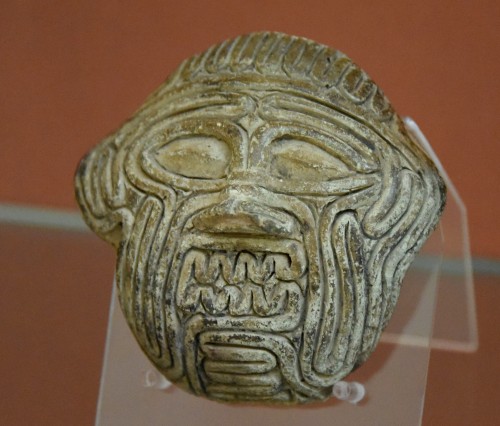
Face of the Demon Humbaba
THE EPIC TALE
In The Epic of Gilgamesh, the great king is thought to be too proud and arrogant by the gods and so they decide to teach him a lesson by sending the wild man, Enkidu, to humble him. Enkidu and Gilgamesh, after a fierce battle in which neither are bested, become friends and embark on adventures together.
They kill Humbaba, demon of the Cedar Forest, and this attracts the attention of Inanna (known by her Akkadian/Babylonian name Ishtar in the story). Inanna tries to seduce Gilgamesh but he rejects her, citing all the other men she has had as lovers who ended their lives poorly. Inanna is enraged and sends her brother-in-law, the Bull of Heaven, down to earth to destroy Gilgamesh. Enkidu comes to his friend's aid and kills the bull but, in doing so, he has offended the gods and is condemned to death.
When Enkidu dies, Gilgamesh falls into a deep grief and, recognizing his own mortality through the death of his friend, questions the meaning of life and the value of human accomplishment in the face of ultimate extinction. He cries:
How can I rest, how can I be at peace? Despair is in my heart. What my brother is now, that shall I be when I am dead. Because I am afraid of death I will go as best I can to find Utnapishtim whom they call the Faraway, for he has entered the assembly of the gods. (Sandars, 97)
Casting away all of his old vanity and pride, Gilgamesh sets out on a quest to find the meaning of life and, finally, some way of defeating death. He travels through the mountains, over vast oceans, and finally locates Utnapishtim who offers him two chances at immortality; both of which he fails. First, he cannot remain awake for six days and six nights and, second, he fails to protect a magic plant; a snake eats the plant while Gilgamesh sleeps. Failing to have won immortality, he is rowed back home by the ferryman Urshanabi and, once there, writes down his story.
LEGACY & CONTINUING DEBATE
Through his struggle to find meaning in life, Gilgamesh defied death and, in doing so, becomes the first epic hero in world literature. The grief of Gilgamesh, and the questions his friend's death evoke, resonate with every human being who has wrestled with the meaning of life in the face of death. Although Gilgamesh ultimately fails to win immortality in the story, his deeds live on through the written word and, so, does he.
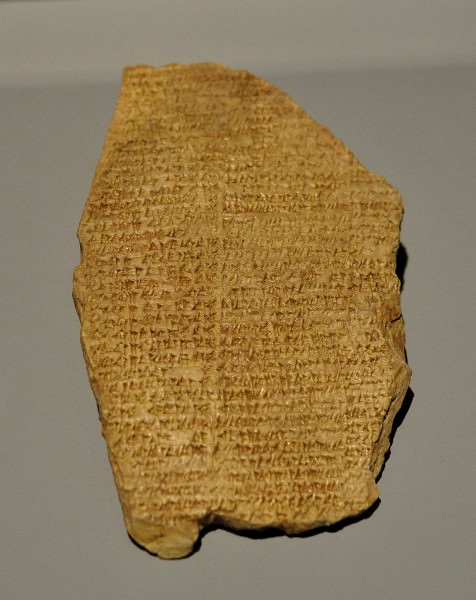
The Story of Gilgamesh and Aga
Since The Epic of Gilgamesh existed in oral form long before it was written down, there has been much debate over whether the extant tale is more early Sumerian or later Babylonian in cultural influence. The best-preserved version of the story, as noted, comes from Shin-Leqi-Unninni who most likely embellished on the original Sumerian source material. Regarding this, the Orientalist Samuel Noah Kramer writes:
Of the various episodes comprising The Epic of Gilgamesh, several go back to Sumerian prototypes actually involving the hero Gilgamesh. Even in those episodes which lack Sumerian counterparts, most of the individual motifs reflect Sumerian mythic and epic sources. In no case, however, did the Babylonian poets slavishly copy the Sumerian material. They so modified its content and molded its form, in accordance with their own temper and heritage, that only the bare nucleus of the Sumerian original remains recognizable. As for the plot structure of the epic as a whole - the forceful and fateful episodic drama of the restless, adventurous hero and his inevitable disillusionment - it is definitely a Babylonian, rather than a Sumerian, development and achievement.(History Begins at Sumer, 270).
Historical evidence for Gilgamesh's existence is found in inscriptions crediting him with the building of the great walls of Uruk (modern day Warka, Iraq) which, in the story, are the tablets upon which he first records his great deeds and his quest for the meaning of life. There are other references to him by known historical figures of his time such as King Enmebaragesi of Kish and, of course, the Sumerian King List and the legends which grew up around his reign.
A GERMAN TEAM OF ARCHAEOLOGISTS CLAIM TO HAVE DISCOVERED THE TOMB OF GILGAMESH IN APRIL OF 2003 CE.
In the present day, Gilgamesh is still spoken of and written about. A German team of Archaeologists claim to have discovered the Tomb of Gilgamesh in April of 2003 CE. Archaeological excavations, conducted through modern technology involving magnetization in and around the old riverbed of the Euphrates, have revealed garden enclosures, specific buildings, and structures described in The Epic of Gilgamesh including the great king's tomb. According to legend, Gilgmesh was buried at the bottom of the Euphrates when the waters parted upon his death.
Whether the historical king existed is no longer relevant, however, as the character has taken on a life of his own over the centuries. At the end of the story, when Gilgamesh lays dying, the narrator says:
The heroes, the wise men, like the new moon have their waxing and waning. Men will say, "Who has ever ruled with might and with power like [Gilgamesh]?" As in the dark month, the month of shadows, so without him there is no light. O Gilgamesh, you were given the kingship, such was your destiny, everlasting life was not your destiny. Because of this, do not be sad at heart, do not be grieved or oppressed; he has given you power to bind and to loose, to be the darkness and the light of mankind. (Sanders, 118)
The story of Gilgamesh's failure to realize his dream of immortality is the very means by which he attains it. The epic itself is immortality and has served as the model for any similar tale which has been written since. It was no doubt widely read prior to the fall of the Assyrian Empire in 612 BCE and has become increasingly popular and influential since its rediscovery in 1879 CE.
Gilgamesh encourages hope in that, even though one may not be able to live forever, the choices one makes in life resonate in the lives of others. These others may be friends, family, acquaintances, or may be strangers living long after one's death who continue to be touched by the eternal story of the hero's refusal to accept a life without meaning. Gilgamesh's struggle against apparent meaninglessness defines him - just as it defines anyone who has ever lived - and his quest continues to inspire those who recognize how eternal and intrinsically human that struggle is.
Hannibal › Who Was
Definition and Origins

Hannibal (also known as Hannibal Barca, 247-183 BCE) was a Carthaginian general during the Second Punic War between Carthage and Rome (218-202 BCE). He is considered one of the greatest generals of antiquity and his tactics are still studied and used in the present day. His father was Hamilcar Barca (275-228 BCE), the great general of the First Punic War (264-241 BCE).
These wars were fought between the cities of Carthage in North Africa and Rome in northern Italy for supremacy in the Mediterranean region and the second war resulted directly from the first. Hannibal assumed command of the troops following his father's death and led them victoriously through a number of engagements until he stood almost at the gates of Rome; at which point he was stopped, not by the Romans, but through a lack of resources to take the city.
He was called back to Africa to defend Carthage from Roman invasion, was defeated at the Battle of Zama in 202 BCE by Scipio Africanus (236-183 BCE) and retired from service to Carthage. The remainder of his life was spent as a statesman and then in voluntary exile at the courts of foreign kings. He died in 183 BCE by drinking poison.
EARLY LIFE
According to the historian Philip Matyszak, "There is much we do not know about this man, though he was one of the greatest generals in antiquity. No surviving ancient biography makes him the subject, and Hannibal slips in and out of focus according to the emphasis that other authors give his deeds and character" (24). Nothing is known of his mother and, although he was married at the time of some of his greatest victories, no records make mention of his wife other than her name, Imilce, and the fact that she bore him a son. What became her her or her son is not known. The story of Hannibal's life is told largely by his enemies, the Romans, through the historians who wrote of the Punic Wars.
AS A BOY, HANNIBAL'S FATHER COMMANDED HIM "TO SWEAR THAT HE WOULD NEVER BE A FRIEND TO ROME".
The Greek historian Polybius writes how Hannibal's father invited him to join an expedition to Spain when the boy was around nine years old. Hannibal eagerly accepted the invitation but, before he was allowed to join up, his father "took Hannibal by the hand and led him to the altar. There he commanded Hannibal to lay his hand on the body of the sacrificial victim and to swear that he would never be a friend to Rome" (3:11). Hannibal took the vow gladly - and never forgot it.
He accompanied his father to Spain and learned to fight, track and, most importantly, out-think an opponent. Matyszak comments how "the modern concept of teenagers as somewhere between child and adult did not exist in the ancient world, and Hannibal was given charge of troops at an early age" (23). When his father drowned, command of the army passed to Hasdrubal the Fair (c.270-221 BCE), Hamilcar's son-in-law, and when Hasdrubal was assassinated in 221 BCE the troops unanimously called for the election of Hannibal as their commander even though he was only 25 years old at the time.
CROSSING THE ALPS & EARLY VICTORIES
Following the First Punic War the treaty between Carthage and Rome stipulated that Carthage could continue to occupy regions in Spain as long as they maintained the steady tribute they now owed to Rome and remained in certain areas. In 219 BCE the Romans orchestrated a coup in the city of of Saguntum which installed a government hostile to Carthage and her interests. Hannibal marched on the city, lay siege to it, and took it. The Romans were outraged and demanded Carthage hand their general over to them; when Carthage refused, the Second Punic War was begun.

Map of Hannibals Route into Italy
Hannibal decided to bring the fight to the Romans and invade northern Italy in 218 BCE by crossing the mountain range of the Alps. He left his brother Hasdrubal (c.244-207 BCE) in charge of the armies in Spain and set out with his men for Italy. On the way, recognizing the importance of winning the people to his side, he portrayed himself as a liberator freeing the people of Spain from Roman control.
His army grew steadily with new recruits until he had 50,000 infantry and 9,000 cavalry by the time he reached the Alps. He also had with him a number of elephants which he had found very useful in terrorizing the Roman army and their cavalry.Upon reaching the mountains he was forced to leave behind his siege engines and a number of other supplies he felt would slow their progress and then had the army begin their ascent.
The troops and their general had to battle not only the weather and the incline but hostile tribes who lived in the mountains. By the time they reached the other side, 17 days later, the army had been reduced to 26,000 men in total and a few elephants.Still, Hannibal was confident he would be victorious and led his men down onto the plains of Italy.
The Romans, meanwhile, had no idea of Hannibal's movements. They never considered he would move his army over the mountains to reach them and thought he was still in Spain somewhere. When word reached Rome of Hannibal's maneuver, however, they were quick to act and sent the general Scipio (father of Scipio Africanus the Elder, who accompanied him) to intercept. The two armies met at the Ticino River where the Romans were defeated and Scipio almost killed
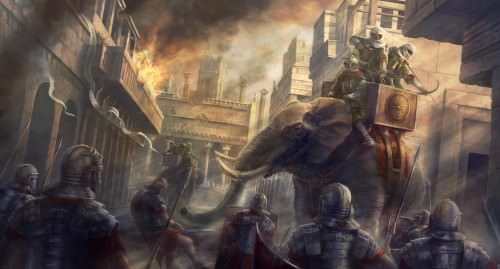
Carthaginian War Elephant
Hannibal next defeated his enemies at Lake Trasimeme and quickly took control of northern Italy. He had no siege machines and no elephants to take any of the cities and so relied on his image as liberator to try to coax the cities over to his side. He then sent word to Carthage for more men and supplies, especially siege engines, but his request was denied. The Carthaginian senate believed he could handle the situation without any added expense on their part and suggested his men live off the land.
HANNIBAL'S TRICKS & THE BATTLE OF CANNAE
Hannibal's strategy of presenting himself as a liberator worked and a number of cities chose to side with him against Rome while his victories on the field continued to swell his ranks with new recruits. After the Battle of Trebbia, where he again defeated the Romans, he retreated for the winter to the north where he developed his plans for the spring campaign and developed various strategems to keep from being assassinated by spies in his camp or hired killers sent by the Romans.Polybius writes how Hannibal,
had a set of wigs made, each of which made him look like a man of a different age. He changed these constantly, each time changing his apparel to match his appearance. Thus he was hard to recognize, not just by those who saw him briefly, but even by those who knew him well. (3:78)
Once spring came, Hannibal launched a new assault, destroying the Roman army under Gaius Flaminius and another under Servilius Geminus.
The Romans then sent the general Fabius Verrucosus against Hannibal who employed a new tactic of wearing Hannibal down by keeping him constantly on the move and off balance. Fabius became known as "the delayer" by refusing to face Hannibal directly and delaying any face-to-face engagement; he preferred instead to strategically place his armies to prevent Hannibal from either attacking or retreating from Italy. So successful was Fabius' strategy that he almost caught Hannibal in a trap.
HANNIBAL SPENT TIME LEARNING ABOUT HIS ENEMY, THEIR STRENGTHS & WEAKNESSES, & KNEW THAT VARRO WAS OVER-CONFIDENT OF SUCCESS.
He had the Carthaginians penned up near Capua where retreat was blocked by the Volturnus River. It seemed that Hannibal had to either fight his way out or surrender but then, one night, the Romans saw a line of torches moving from the Carthaginian camp emplacement toward an area they knew was held by a strong garrison of their own. It seemed clear Hannibal was trying to break out of the trap. Fabius' generals encouraged him to mount a night attack to support the garrison and crush the enemy between them but Fabius refused, believing that the garrison in place could easily prevent Hannibal from breaking out and would hold until morning. When the garrison mobilized to march out and meet Hannibal in battle, however, they found only cattle with torches tied on their horns and Hannibal's army had slipped away through the pass the Romans had left untended.
Hannibal then marched to the Roman supply depot of Cannae, which he took easily, and then gave his men time to rest. The Romans sent the two consuls Lucius Aemilius Paulus and Caius Terentius Varro, with a force of over 50,000, against his position; Hannibal had less than 40,000 men under his command. As always, Hannibal spent time learning about his enemy, their strengths and weaknesses, and knew that Varro was eager for a fight and over-confident of success. As the two consuls traded off command of the army, it worked to Hannibal's advantage that the more ambitious and reckless of the two, Varro, held supreme authority on the first day of battle.
Hannibal arranged his army in a crescent, placing his light infantry of Gauls at the front and center with the heavy infantry behind them and light and heavy cavalry on the wings. The Romans under Varro's command were placed in traditional formation to march toward the center of the enemy's lines and break them. Varro believed he was facing an opponent like any of the others Roman legions had defeated in the past and was confident that the strength of the Roman force would break the Carthaginian line; this was precisely the conclusion Hannibal hoped he would reach.

Battle of Cannae - Initial Deployment
When the Roman army advanced, the center of the Carthaginian line began to give way so that it seemed as though Varro had been correct and the center would break. The Carthaginian forces fell back evenly, drawing the Romans further and further into their lines, and then the light infantry moved to either end of the crescent formation and the heavy infantry advanced to the front. At this same time, the Carthaginian cavalry engaged the Roman cavalry and dispersed them, falling on the rear on the Roman infantry.
The Romans, continuing in their traditional formation with their well-rehearsed tactics, continued to press forward but now they were only pushing those in the front lines into the killing machine of the Carthaginian heavy infantry. The Carthaginian cavalry had now closed the gap behind and the forces of Rome were completely surrounded. Of the 50,000 plus Roman soldiers who took the field that day only 10,000 escaped; 44,000 were killed while Hannibal lost around 6,000 men. It was a devastating defeat for Rome which resulted in a number of the Italian city-states defecting to Hannibal and Philip V of Macedon declaring in favor of Hannibal and initiating the First Macedonian War with Rome.
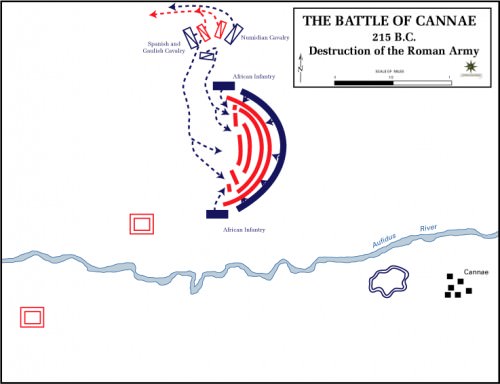
Battle of Cannae - Destruction of the Roman Army
The people of Rome mobilized to defend their city, which they were sure Hannibal would move on next. Veterans and new recruits alike refused pay in order to defend the city. Hannibal, however, could make no move on Rome because he lacked siege engines and reinforcements for his army. His request for these necessary supplies was refused by Carthage because the senate did not want to exert the effort or spend the money.
Hannibal's commander of the cavalry, Maharbal, encouraged Hannibal to attack anyway, confident they could win the war at this point when the Roman army was in disarray and the people in a panic. When Hannibal refused, Maharbal said, "You know how to win a victory, Hannibal, but you do not know how to use it." Hannibal was right, however; his troops were exhausted after Cannae and he had neither elephants nor siege engines to take the city. He did not even have enough men to reduce the city by encircling it for a long siege. If Carthage had sent the requested men and supplies at this point history would have been written very differently; but they did not.
FURTHER CAMPAIGNS & THE BATTLE OF ZAMA
Among the Roman warriors who survived Cannae was the man who would come to be known as Scipio Africanus the Elder.Scipio's father and uncle, two of the former commanders, had been killed fighting Hasdrubal in Spain and, when the Roman senate called for a general to defend the city against Hannibal all of the most likely commanders refused believing, after Cannae, that any such command was simply a suicide mission. Scipio, only 24 years old at the time, volunteered. He left Rome with only 10,000 infantry and 1,000 cavalry to meet Hannibal's much larger force.
Scipio began in Spain - not Italy - in an effort to subdue Hasdrubal first and prevent reinforcements from reaching Italy. He first took the city Carthago Nova and moved on from there to other victories. In 208 BCE, he defeated Hasdrubal at the Battle of Baecula using the same tactic Hannibal had at Cannae.
HASDRUBAL, RECOGNIZING THAT SPAIN WAS A LOST CAUSE, CROSSED THE ALPS TO JOIN HANNIBAL IN ITALY FOR A UNITED ATTACK ON ROME.
Hasdrubal, recognizing that Spain was a lost cause, crossed the Alps to join Hannibal in Italy for a united attack on Rome. At the Battle of the Metaurus River in 207 BCE, however, Hasdrubal's army was defeated by the Romans under Gaius ClaudiusNero (c. 237-199 BCE); Hasdrubal was killed and his forces scattered. Nero had been engaging Hannibal in the south but slipped away in the night, defeated Hasdrubal, and returned without Hannibal ever noticing. The first Hannibal knew of Hasdrubal's defeat was when a Roman contingent threw his brother's head to the sentries of his camp.
Scipio, still in Spain, requested money and supplies from the Roman senate to take the fight to Hannibal by attacking Carthage; a move which, he was sure, would force Carthage to recall Hannibal from Italy to defend the city. The Roman senate refused and so Scipio shamed them by raising his own army and appealing to the people of Rome for support; the senate then relented and gave him command of Sicily from which to launch his invasion of North Africa.
Hannibal, in the meantime, was forced to continue his previous strategy of striking at Rome in quickly orchestrated engagements, and trying to win city-states to his cause, without being able to take any city by storm. The historian Matyszak writes, "In the field, Hannibal remained umatched. In 212 and 210 he took on the Romans and defeated them. But he now understood that the wound Rome had received at Cannae had not been mortal. The flow of defections to the Carthaginian side slowed and then stopped" (39). In Spain, the Carthaginians had been defeated by Scipio but Hannibal had no knowledge of this; he only knew his brother had been killed but not that Spain was under Roman control.
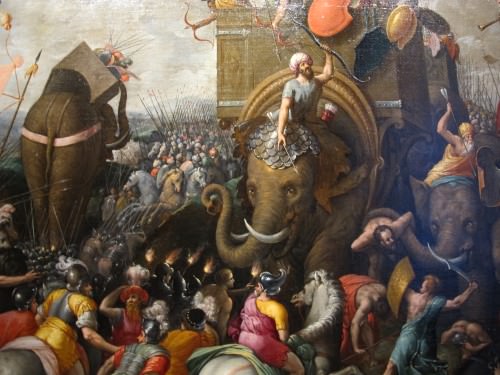
Battle of Zama
By this time, Scipio was already set to invade North Africa and his plan would work exactly as he predicted. In 205 BCE he landed his forces and allied himself with the Numidian King Masinissa. He quickly took the Carthaginian city of Utica and marched on toward Carthage. Hannibal was recalled from Italy to meet this threat and the two forces met on the field in 202 BCE at the Battle of Zama.
Scipio had studied Hannibal's tactics carefully in the same way that Hannibal had always taken pains to know his enemy and out-think his opponents. He had no experience in facing Scipio, however, and only knew him as the young general who had somehow managed to defeat Hasdrubal in Spain. Scipio seemed to conform to Hannibal's expectations when he arranged his forces in traditional formation in a seemingly tight cluster.
Hannibal was certain he would scatter these Romans easily with an elephant charge but Scipio used his front line as a screen for a very different kind of formation: instead of the closely-packed configuration presenting a horizontal front across the line (the formation Hannibal saw from his position) he arranged his troops in vertical rows behind the front line. When Hannibal launched his elephant charge, Scipio's front line simply moved aside and the elephants ran harmlessly down the alleys between the Roman troops who then killed their handlers and turned the elephants around to crush the ranks of the Carthaginians; Hannibal was defeated and the Second Punic War was over.

The Battle of Zama - Elephant Charge
LATER YEARS & LEGACY
After the war, Hannibal accepted a position as Chief Magistrate of Carthage in which he performed as well as he had as a military leader. The heavy fines imposed on defeated Carthage by Rome, intended to cripple the city, were easily paid owing to the reforms Hannibal initiated. The members of the senate, who had refused to send him aid when he needed it in Italy, accused him of betraying the interests of the state by not taking Rome when he had the chance but, still, Hannibal remained true to the interests of his people until the senators trumped up further charges and denounced Hannibal to Rome claiming he was making Carthage a power again so as to challenge the Romans. Exactly why they decided to do this is unclear except for their disappointment in him following defeat at Zama and simple jealousy over his abilitites.
In Rome, Scipio was also dealing with problems posed by his own senate as they accused him of sympathizing with Hannibal by pardoning and releasing him, accepting bribes, and misappropiating funds. Scipio defended Hannibal as an honorable man and kept the Romans from sending a delegation demanding his arrest but Hannibal understood it was only a matter of time before his own countrymen turned him over and so he fled the city in 195 BCE for Tyre and then moved on to Asia Minorwhere he was given the position of consultant to Antiochus III, the Seleucid king.
Antiochus, of course, knew of Hannibal's reputation and did not want to risk placing so powerful and popular a man in control of his armies and so kept him at court until necessity drove him to appoint Hannibal admiral of the navy in a war against Rhodes, one of Rome's allies. Hannibal was an inexperienced sailor, as was his crew, and was defeated even though, much to his credit, he came close to winning. When Antiochus was defeated by the Romans at Magnesia in 189 BCE, Hannibal knew that he would be surrendered to the Romans as part of the terms and again took flight.

Hannibal Barca
At the court of King Prusias of Bithynia in 183 BCE, with Rome still in pursuit, Hannibal chose to end his life rather than be taken by his enemies. He said, "Let us put an end to this life, which has caused so much dread to the Romans" and then drank poison. He was 65 years old. During this same time, in Rome, the charges against Scipio had disgusted him so much that he retreated to his estate outside the city and left orders in his will that he be buried there instead of in Rome. He died the same year as Hannibal at the age of 53.
Hannibal became a legend in his own lifetime and, years after his death, Roman mothers would continue to frighten their unwilling children to bed with the phrase "Hannibal ad Porto" (Hannibal is at the door). His campaign across the Alps, unthinkable even in his day, won him the grudging admiration of his enemies and enduring fame ever since.
Hannibal's strategies, learned so well by Scipio, were incorporated into Roman tactics and Rome would consistently use them to good effect following the Battle of Zama. After the deaths of Hannibal and Scipio, Carthage continued to cause problems for Rome which eventually resulted in the Third Punic War (149-146 BCE) in which Carthage was destroyed.
The historian Ernle Bradford writes that Hannibal's war against the Romans,
may be regarded as the last effort of the old eastern and Semitic peoples to prevent the domination of the Mediterranean world by a European state. That it failed was due to the immense resilience of the Romans, both in their political constitution and in their soldiery (210).
While there is some truth to this, Hannibal's ultimate defeat was brought about by his own people's weakness for luxury, wealth, and ease as much as by the Roman refusal to surrender after Cannae. There is no doubt, as Bradford also notes, that had Hannibal "been fighting against any other nation in the ancient world...his overwhelming victories would have brought them to their knees and to an early capitulation" (210) but the cause of Hannibal's defeat was just as much the fault of the Carthaginian elite who refused to support the general and his troops who were fighting for their cause.
No records exist of Carthage awarding Hannibal any recognition for his service in Italy and he was honored more by Scipio's pardon and defense than by any actions on the part of his country. Even so, he continued to do his best for his people throughout his life and remained true to the vow he had taken when young; to the end, he remained an enemy of Rome and his name would be remembered as Rome's greatest adversary for generations - and even to the present day.
Minoan Civilization › Antique Origins
Definition and Origins
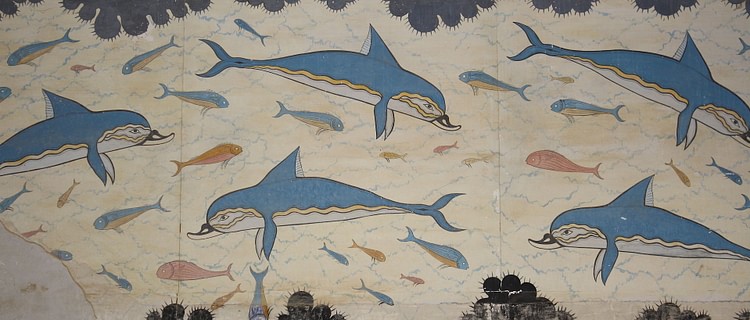
The Minoan civilization flourished in the Middle Bronze Age on the island of Crete located in the eastern Mediterranean from c. 2000 BCE until c. 1500 BCE. With their unique art and architecture, and the spread of their ideas through contact with other cultures across the Aegean, the Minoans made a significant contribution to the development of Western European civilization as it is known today. Labyrinth -like palace complexes, vivid frescoes depicting scenes such as bull-leaping and processions, fine gold jewellery, elegant stone vases, and pottery with vibrant decorations of marine life are all particular features of Minoan Crete.
ARTHUR EVANS & DISCOVERY
The archaeologist Sir Arthur Evans was first alerted to the possible presence of an ancient civilization on Crete by surviving carved seal stones worn as charms by native Cretans in the early 20th century CE. Excavating at Knossos from 1900 to 1905 CE, Evans discovered extensive ruins which confirmed the ancient accounts, both literary and mythological, of a sophisticated Cretan culture and possible site of the legendary labyrinth and palace of King Minos. It was Evans who coined the term Minoan in reference to this legendary Bronze Age king. Evans, seeing what he believed to be the growth and decline of a unified culture on Crete, divided the island's Bronze Age into three distinct phases largely based on different pottery styles:
- Early Bronze Age or Early Minoan (EM): 3000-2100 BCE
- Middle Bronze Age or Middle Minoan (MM): 2100-1600 BCE
- Late Bronze Age or Late Minoan (LM): 1600-1100 BCE
The above divisions were subsequently refined by adding numbered subphases to each group (eg MM II). Radio-carbon dating and tree-ring calibration techniques have helped to further refine the dates so that the Early Bronze Age now begins c.3500 BCE and the Late Bronze Age c. 1700 BCE. An alternative to this series of divisions, created by Platon, instead focuses on the events occurring in and around the major Minoan “palaces”. This scheme has four periods:
- Prepalatial: 3000 - 2000/1900 BCE
- Protopalatial: 2000/1900 - 1700 BCE
- Neopalatial: 1700 - 1470/1450 BCE
- Postpalatial: 1470/1450 - 1100 BCE
Both of these schemes have since been challenged by more modern archaeology and approaches to history and anthropology in general which prefer a more multilinear development of culture on Crete with a more complex scenario involving conflicts and inequalities between settlements and which also considers their cultural differences as well as their obvious similarities.
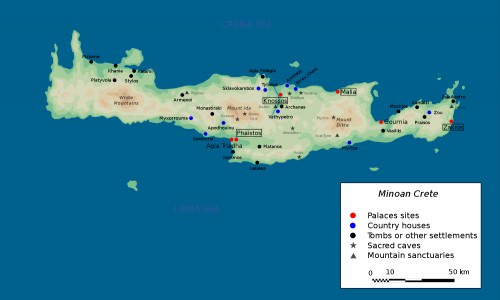
Map of Minoan Crete
MINOAN PALACE SETTLEMENTS
Minoan settlements, tombs, and cemeteries have been found all over Crete but the four principal palace sites (in order of size) were:
- Knossos
- Phaistos
- Malia
- Zakros
MINOAN PALACES EXERTED SOME KIND OF LOCALISED CONTROL, IN PARTICULAR, IN THE GATHERING & STORAGE OF SURPLUS MATERIALS.
At each of these sites, large, complex palace structures seem to have acted as local administrative, trade, religious, and possibly political centres. The relationship between the palaces and the power structure within them or over the island as a whole is not clear due to a lack of archaeological and literary evidence. It is clear, however, that the palaces exerted some kind of localised control, in particular, in the gathering and storage of surplus materials - wine, oil, grain, precious metals and ceramics. Small towns, villages, and farms were spread around the territory seemingly controlled by a single palace. Roads connected these isolated settlements to each other and the main centre. There is a general agreement among historians that the palaces were independent from each other up to 1700 BCE, and thereafter they came under the sway of Knossos, as evidenced by a greater uniformity in architecture and the use of Linear A writing across various palace sites.
The absence of fortifications in the settlements suggests a relatively peaceful co-existence between the different communities.However, the presence of weapons such as swords, daggers, and arrowheads, and defensive equipment such as armour and helmets would also suggest that peace may not always have been enjoyed. Minoan roads, too, have evidence of regular guardhouses and watchtowers suggesting that banditry, at least, troubled the unprotected traveller.
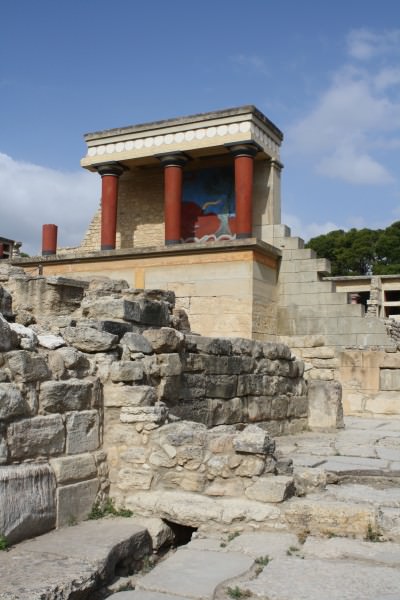
Palace of Knossos
The palaces themselves covered two periods. The first palaces were constructed around 2000 BCE and, following destructive earthquakes and fires, rebuilt again c. 1700 BCE. These second palaces survived until their final destruction between 1500 BCE and 1450 BCE, once again by either earthquake, fire, or possibly invasion (or a combination of all three). The palaces were well-appointed, monumental structures with large courts, colonnades, ceilings supported by tapered wooden columns, staircases, religious crypts, light-wells, extensive drainage systems, large storage magazines and even 'theatre' areas for public spectacles or religious processions.
DEPICTIONS OF DOUBLE AXES (OR LABRYS) & THE COMPLEX PALACES MAY HAVE COMBINED TO GIVE BIRTH TO THE LEGEND OF THESEUS & THE LABYRINTH-DWELLING MINOTAUR.
Reaching up to four stories high and spreading over several thousand square metres, the complexity of these palaces, the sport of bull-leaping, the worship of bulls as indicated by the presence throughout of sacred bulls' horns and depictions of double axes (or labrys ) in stone and fresco may all have combined to give birth to the legend of Theseus and the labyrinth-dwelling Minotaur so popular in later classical Greek mythology.
RELIGION
The religion of the Minoans remains sketchy, but details are revealed through art, architecture, and artefacts. These include depictions of religious ceremonies and rituals such as the pouring of libations, making food offerings, processions, feasts, and sporting events like bull-leaping. Natural forces and nature in general, manifested in such artworks as a voluptuous female mother-earth goddess figure and male figure holding several animals, seem to have been revered. Palaces contain open courtyards for mass gatherings and rooms often have wells and channels for the pouring of libations, as previously noted. As already mentioned, too, bulls are prominent in Minoan art, and their horns are an architectural feature of palace walls and a general decorative element in jewellery, frescoes, and pottery decoration. Dramatic rural sites such as hilltops and caves often show evidence of cult rituals being performed there.
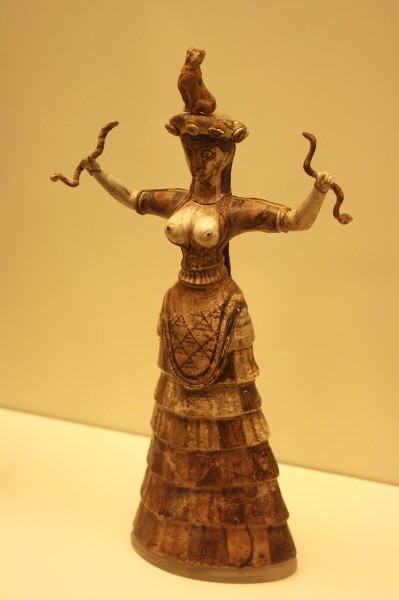
Minoan Snake Goddess, Knossos.
MATERIAL CULTURE
The sophistication of the Minoan culture and its trading capacity is evidenced by the presence of writing, firstly Cretan Hieroglyphic (c. 2000-1700 BCE) and then Linear A scripts (both, as yet, undeciphered), predominantly found on various types of administrative clay tablets. Seal impressions on clay were another important form of record keeping.
A further example of the culture's high degree of development is the variety and quality of the art forms practised by the Minoans. Pottery finds reveal a wide range of vessels from wafer-thin cups to large storage jars ( pithoi ). Ceramics were initially hand-turned but then increasingly made on the potter's wheel. In decoration, there was a progression from flowing geometric designs in Kamares ware to vibrant naturalistic depictions of flowers, plants, and sea life in the later Floral and Marine styles. Common pottery shapes include three-handled amphorae, tall beaked-jugs, squat round vessels with a false spout, beakers, small lidded boxes, and ritual vessels with figure-of-eight-shaped handles. Stone was also used to produce similar vessel types and rhyta (ritual vessels for pouring libations, often in the shape of animal heads).
Large-scale figure sculpture has not survived but there are many figurines in bronze and other materials. Early types in clay show the dress of the time with men (coloured red) wearing belted loincloths and women (coloured white) in long flowing dresses and open-fronted jackets. A leaping acrobat in ivory and the faience snake goddess already mentioned are notable works which reveal the Minoan love of capturing figures in active striking poses.
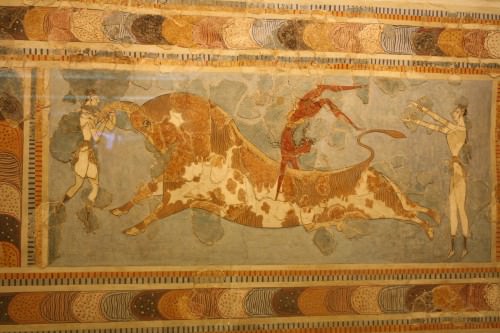
Minoan Bull Leaping
Magnificent frescoes from the walls, ceilings, and floors of the palaces also reveal the Minoans' love of the sea and nature and give insights into religious, communal, and funeral practices. Subjects range in scale from miniature to larger-than-life size.The Minoans were one of the earliest cultures to paint natural landscapes without any humans present in the scene; such was their admiration of nature. Animals, too, were often depicted in their natural habitat, for example, monkeys, birds, dolphins, and fish. Although Minoan frescoes were often framed with decorative borders of geometric designs, the principal fresco itself, on occasion, went beyond conventional boundaries such as corners and covered several walls of a single room, surrounding the viewer.
MINOAN ARTISTS, ESPECIALLY FRESCO PAINTERS, TOOK THEIR SKILLS TO THE ROYAL PALACES OF EGYPT & THE LEVANT.
AEGEAN CONTACTS
The Minoans, as a seafaring culture, were also in contact with foreign peoples throughout the Aegean, as evidenced by the Near Eastern and Egyptian influences in their early art but also in the later export trade, notably the exchange of pottery and foodstuffs such as oil and wine in return for precious objects and materials such as copper from Cyprus and Attica and ivory from Egypt. Several Aegean islands, especially in the Cyclades, display the characteristics of a palace-centred economy and political structure as seen on Crete while Minoan artists, especially fresco painters, took their skills to the royal palaces of Egypt and the Levant.
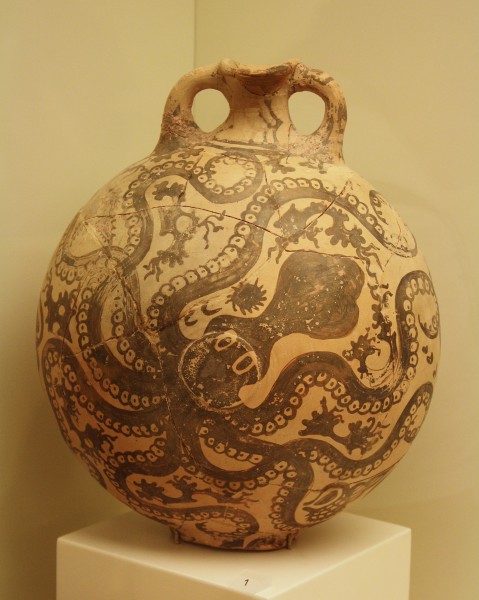
Minoan Vase in Marine Style
DECLINE
The reasons for the demise of the Minoan civilization continue to be debated. Palaces and settlements show evidence of fire and destruction c. 1450 BCE, but not at Knossos (which was destroyed perhaps a century later). The rise of the Mycenaean civilization in the mid-2nd millennium BCE on the Greek mainland and the evidence of their cultural influence on later Minoan art and trade make them the most likely cause. However, other suggestions include earthquakes and volcanic activity with a consequent tsunami. The eruption of Thera (the present-day island of Santorini) may have been particularly significant, although, the exact date of this cataclysmic eruption is disputed and therefore its connection with the end of the Minoan period remains unclear. The most likely scenario was probably a fatal mix of natural environmental damage and competition for wealth weakening the structure of society, which was then exploited by invading Mycenaeans. Whatever the cause, most of the Minoan sites were abandoned by 1200 BCE and Crete would not return to the Mediterranean stage of history until the 8th century BCE when it was colonised by Archaic Greeks.
MAP
LICENSE:
Article based on information obtained from these sources:with permission from the Website Ancient History Encyclopedia
Content is available under License Creative Commons: Attribution-NonCommercial-ShareAlike 3.0 Unported. CC-BY-NC-SA License